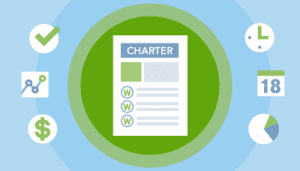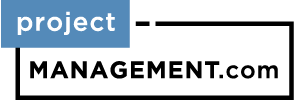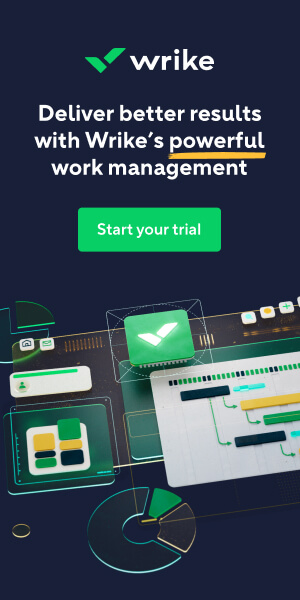
A project charter outlines the details and potential benefits of a project and help teams and customers better understand its development.
Project charters appeal to project sponsors and team members alike by defining a project’s goals and needs. With an accurate, well-written charter, everyone involved in a project is able to understand the importance of its success, as well as the steps needed to complete it.
What Is a Project Charter?
A project charter is a short document that explains the project in clear, concise wording for high-level management. Project charters outline the entirety of projects to help teams quickly understand the goals, tasks, timelines, and stakeholders. It is an essential deliverable in any project and one of the first deliverables as prescribed by the PMBOK Guide and other best practice standards. The document provides key information about a project and also provides approval to start the project. Therefore, it serves as a formal announcement that a newly approved project is about to commence. Contained also in the project charter is the appointment of the project manager, the person who is overall responsible for the project.
Who are Project Charters for?
A project charter should be viewed by any individual in connection with a developing project. That said, there are a few specific groups that are best served by the creation of a project charter. These are project teams, especially the project manager, and sponsors of the project. A charter is used by sponsors to determine the potential usefulness of a project. They are also used, on occasion, to raise funds.
Project Teams
A project charter helps teams by marking the official beginning of a project. It also outlines the structure of the development team by designating a project manager and describes all goals and/or complications that the team wants to address.
Project Sponsors
The project charter will also note the sponsors of the project. This may be one person/organization, or many. The project charter can also be used as proof of a project’s viability when finding other potential clients and sponsors.
What Information Does the Project Charter Contain?
When preparing the project charter, utilize the SMART method. Be Specific, and ensure your goals are Measurable, Attainable, Relevant to the project, and Timebound. The project charter includes:
- Purpose and objectives of the project in clear, concise language
- Requirements of the project at a very high level and without much detail
- Project description in a paragraph or two that explains the project
- Known high-level, major categories of risks for the project
- Schedule of events with the start and end dates
- Major events or milestones along the path.
- Budget or summary of how much the project will cost
- Requirements from the organization for approval, including what to approve, who will approve, and how to get the approval
- Key players or stakeholders in charge of which parts of the project and who will approve the plans to go through
- An introduction of the project manager, project sponsor, and their authority level
Read also: How to Write SMART Project Management Goals
Featured Partners: Project Management Software
Main Components of a Project Charter
A project charter is a living document outlining the issues, targets, and framework. A charter needs six main components that define the reasons for the project, explains how it improves the business, enumerate what steps are necessary to complete, and identify the stakeholders responsible for the project. The project charter components are:
- Problem statement
- Business case
- Goal statement
- Timeline
- Scope
- Team members
Why Are Project Charters Useful?
The main reason every project needs a project charter at the very start is that without it, there is no proof or official document that an authorized project manager defined and presented a project and gained its approval from stakeholders to proceed. A project charter also provides several benefits:
- Formally authorizes the project to commence
- Creates a common vision and shared understanding of the project
- Empowers the project manager to lead the project
- Identifies the high-level objectives and scope of the project
- Defines what success will look like at the end of the project
- Gains support for the project by announcing it to the whole organization
- Ensures that key stakeholders are aware of the project
- Secures budget and resources for the project
- Serves as the point of reference for the project team
Read also: Significance of Keeping Documentation in Project Management
Key Sections of a Project Charter
Most project management methodologies and frameworks prescribe the use of a project charter but do not define the actual contents of the template. This is understandable because projects differ in a variety of ways, such as in size, criticality, type, or approach. But the accepted principle in writing a project charter is that the document should help clarify the what, why, who, when, and what cost aspects or questions of the project. Referencing the PMBOK Guide, the inclusion of the following sections in a project charter will address these aspects and questions:
Project information
This section includes the name of the project, its ID (if organizations use one), the name of the project manager, and its sponsor(s). It can also include additional but brief project description details.
Business need, problem, or opportunity
This section tries to identify what the main driver for the project is for it to exist. It provides the context or situation that led the sponsor to start the project.
Project objectives and benefits
This lists the goals that the project will try to achieve. A guide for writing the objectives is to use the SMART acronym: they should be Specific, Measurable, Attainable, Realistic, and Time-bound.
Project organization
This section identifies the people governing the project. It should clearly show the key roles for its management and direction. Using a RACI chart can be helpful.
High-level project scope
This section outlines the boundaries of the project at a high level. It is important to identify not only its scope but also what will be considered out of scope for the project. Specifying key deliverables of the project should also fall in this section. Project deliverables can be simple or complex in scope.
High-level project timescale
The project charter should list the key stages and the estimated duration of the project at a high level, including its milestones. However, the project manager should exercise caution in writing the project schedule, assuming that the project will immediately start after the approval.
Adding scheduling data to your project charter is important, though it doesn’t need to be complex. You should state the proposed beginning and end of the project, as well as identifying major deadlines and miklestones throughout the process. Some scheduling information may also be included when discussing the scope of the project.
High-level project budget
This section identifies the budget requirements of the project at a high level. It should include capital and revenue expenditure forecasts.
Key assumptions
This section lists the main assumptions that the project team took. It is important also to assess how these assumptions can impact the project should the team realize later that the assumptions they made were false or inaccurate.
Key project risks
This lists the main risks that may impact the project if they materialize. It assumes that the project team cannot avoid encountering the identified risks.
Success criteria
This section identifies the key metrics to help assess if the project is successful or not. The measurable terms describe an outcome that is acceptable to the end-user, customer, and stakeholders.
One-Page Project Charter Example
When creating a project charter, it is important to understand context. Project charters are usually very lengthy documents. This is to ensure that it completely describes the background of the project, the different options considered, the details of the scope, and other factors. For large projects, an additional one-page Project Charter Summary provides the summary of the most important sections of the full project charter. For small projects, this one-page template is an acceptable alternative. This short project charter is also useful when communicating with executives, who are usually not interested in all of the details and particulars. The sections of the document are as follows:
- Project Name
- Project Description
- Target Date
- Costs
- Gains
- Project Team
- Key Milestones
Tips for Writing a Project Charter
Writing effective project charters comes with experience. However, it is possible to write good enough ones early on by following some advice from professionals who have spent their careers learning how to write great project charters.
Keep it brief
Try to keep the project charter simple and brief. Most likely, the more pages it contains, the less chances it will get read.
Be explicit
Try to get to the point as early as possible. Project sponsors and other stakeholders are busy professionals who may not show interest or enthusiasm reading a vague summary of a project.
Build it with your sponsor
Most often, the sponsor hands it over to the project manager to write the project charter. However, the project charter is always better with the involvement of the sponsor, whether in support or actually co-creating and reviewing the document.
The Benefits of Project Charters
Charters Help Project Teams Begin Development
A project charter initiates the beginning of the project development phase. But it does even more to aid in the development process. The document allows teams to designate the desired features of the project. This also means deciding the features that shouldn’t be included in the project. This means that teams are able to better focus on their projects by eliminating unnecessary software or hardware tools.
Project charter documents are also used by teams to decide upon — and then pursue — the project deliverables. Essentially, the document helps to make your team more productive by focusing members on the most important aspects of a project.
Charters Inform Sponsors/Clients
Sponsors of your project need to see that ypiu and your team are in alignment regarding the goals and resources involved in any project that they are sponsoring. A successful project charter goes a long way in proving to your sponsors that your team is capable of delivering a viable product.
Project charters can also be used by current sponsors or teams to find other prospective investors. The charter shows how the project will progress and how much you expect to spend while working. T
Charters Define Goals and Successes
Project charters differ from RTM documents by giving teams space to describe their work. You clearly outline your goals and deliverables and also specify what it means to be successful.
Details are important for your team to understand how you’re going to finish your project. And, depending on the complexity of your project, you may have many elements that need to be successful, or only a few. This helps to focus your team on project development by drawing attention to the essential parts of the project.
Next Steps for Your Project Charter
After creating the project charter, encourage the sponsor to sign off without delay. Without the sign-off, there is no formal approval and authorization—and no project. Also, it is advisable to share the document promptly after approval. When more people in the organization know what the project is about, the easier it is to have supporters on board. Since the project charter is a key document in the initiation phase of a project, creating a great project charter lays the right foundation for the project and provides a greater chance it will proceed smoothly in its remaining phases.
Tools for Planning and Upholding a Project Charter
Project management software can play an important role in developing your project’s charter by allowing your team to analyze risks and choose appropriate stakeholders based on their existing resources and abilities. Project management tools also provide a view of the project’s timeline, each goal, and the progress team members make. Below, we’ve gathered some examples of project management software that helps keep teams more aware of progress toward achieving the project charter you’ve worked so hard on.












